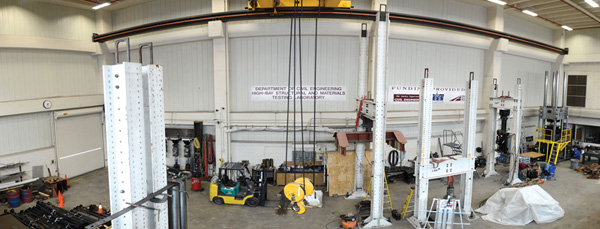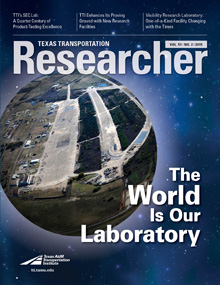Standing outside of the Wisenbaker Engineering Building on the Texas A&M University campus, you’d never guess inside is one of the largest, most modern and best-equipped facilities of its kind — the High-Bay Structural Testing Facility.
The High-Bay Lab enables researchers to perform full-scale tests on structural systems using different types of loads that simulate real-world conditions. With a ceiling height of 40 feet and a heavily reinforced floor, this 4,000-square-foot laboratory accommodates a variety of structural samples simultaneously.

Lab Director Peter Keating explains: “The only way to see the true behavior of structures is to do full-scale tests. That’s what this lab allows us to do.”
The lab, operated by the Texas A&M University Zachry Department of Civil Engineering, has a strong floor consisting of three 12-foot-deep box girders covered with a 2-foot-thick heavily reinforced concrete slab for large-scale testing. Tie-down holes throughout the floor are on 3-foot centers. Each tie-down hole can withstand a service load of 100 kips exerted either upward or downward. (A kip is a non-SI unit that equals 1,000 pounds of force.) The area has temperature and humidity controls, and a 20-ton overhead crane.
When Texas A&M Transportation Institute (TTI) Assistant Research Engineer Joe Bracci was looking for a way to test how bridges with alkali-silica reaction (ASR) cracking would hold up in an overloaded state, the High-Bay Lab was the obvious choice.
“It [ASR] was an issue found in bridges in Texas. We wanted to determine if the bridges were still safe under a failure load — for instance, a hurricane evacuation,” said Bracci. “The High-Bay Lab has the capacity for testing those types of loads.”
Bridges are just one of many items tested at the facility — pipes, scaffolding and even a Civil War-era ship, the CSS Georgia, have been tested there.
“We ran tests to determine how to safely pick up sections of the CSS Georgia located in the Savannah River without damaging them,” says Keating. “They’ve been there for 150 years, so they’re very fragile.”
